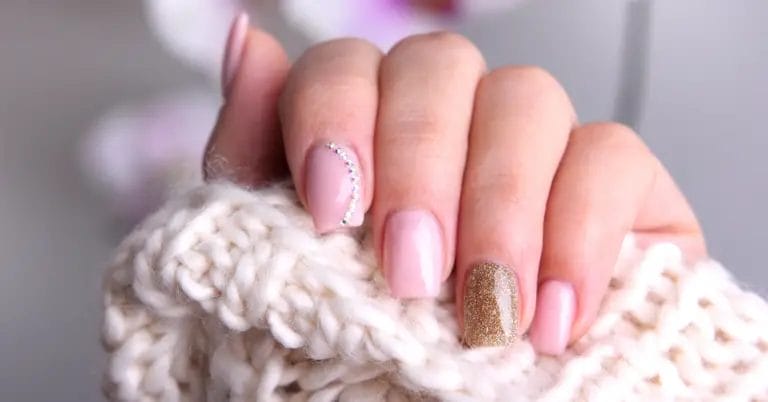Polygel and acrylic are both popular options for nail enhancements. However, when it comes to the debate of which is better, it ultimately depends on the individual’s preference and needs.
Polygel combines the best of both gel and acrylic, offering a lightweight and flexible feel with the durability of acrylic. It is also odorless and doesn’t require excessive filing. On the other hand, acrylic nails are known for their strength and longevity.
Ultimately, whether polygel or acrylic is better is subjective and varies from person to person. It’s best to consult with a nail technician to determine which option suits your specific requirements and preferences.

Advantages and Disadvantages of Acrylic Nails
Acrylic nails have become increasingly popular in recent years due to their durability and ability to enhance the appearance of natural nails. However, like any beauty treatment, there are both advantages and disadvantages to consider before deciding to get acrylic nails. In this section, we will explore the pros and cons of acrylic nails to help you make an informed decision.
Advantages of Acrylic Nails
- Durability: One of the main advantages of acrylic nails is their durability. Acrylic nails are known to be strong and long-lasting, making them ideal for individuals who have weak or brittle natural nails.
- Customizable: Acrylic nails offer a wide range of customization options. You can choose the length, shape, and color of your acrylic nails, allowing you to achieve the desired look that suits your style and personality.
- Easy to Maintain: Unlike natural nails that require constant filing and shaping, acrylic nails are low maintenance. They do not chip easily and can be easily filled in and repaired if necessary.
- Enhanced Nail Length: Acrylic nails are an excellent solution for individuals who struggle to grow their natural nails. They provide instant length, allowing you to achieve the desired nail length without waiting for your natural nails to grow.
- Wide Range of Designs: Acrylic nails offer endless design possibilities. You can experiment with various nail art techniques, such as French tips, ombre, glitter, and intricate patterns, to create unique and eye-catching designs.
Disadvantages of Acrylic Nails
- Damage to Natural Nails: One of the main drawbacks of acrylic nails is the potential damage they can cause to your natural nails. The application and removal process of acrylic nails can weaken your natural nails, leaving them thin and brittle.
- Prone to Infections: Improper maintenance and hygiene can lead to bacterial or fungal infections in the nail bed. It is essential to ensure that your nail technician follows proper sanitization procedures and uses high-quality products to minimize the risk of infections.
- Requires Professional Removal: Acrylic nails need to be professionally removed to avoid damaging your natural nails. Attempting to remove them at home can result in nail damage and pain.
- Potential Allergic Reactions: Some individuals may have allergic reactions to the chemicals used in acrylic nail application. It is crucial to do a patch test before getting acrylic nails to check for any allergies.
- Time-consuming Application: Acrylic nails require multiple steps and layers, which can be time-consuming. The application process may take longer compared to other nail enhancement options.
Now that you are aware of the advantages and disadvantages of acrylic nails, you can make an informed decision based on your personal preferences and priorities. It is important to weigh the pros and cons and consult with a professional nail technician before getting acrylic nails.

Comparing the Durability of Polygel and Acrylic
When it comes to nail extensions and enhancements, two popular options are polygel and acrylic. Both offer the ability to create long-lasting and beautiful nails, but they have some key differences, especially when it comes to durability. In this section, we will compare the durability of polygel and acrylic, helping you make an informed decision about which option is best for you.
1. Application Process
Polygel is a hybrid product that combines the best of both gel and acrylic. It is applied using a slip solution and then cured under a UV or LED lamp. On the other hand, acrylic is a mixture of liquid monomer and powdered polymer that is applied using a brush and air-dries to form a hardened nail. The application process of polygel and acrylic can affect their durability.
2. Strength and Hardness
Acrylic nails are known for their strength and hardness. They are less flexible than polygel nails, which makes them less prone to breakage. Acrylic nails can withstand rougher treatment and are less likely to chip or lift. On the other hand, polygel nails have a bit more flexibility, which can make them more comfortable to wear. However, this flexibility also means that they may be more prone to bending or breaking under pressure.
3. Lifespan
The lifespan of a nail enhancement depends on various factors, including the care and maintenance routine. Generally, acrylic nails tend to have a longer lifespan compared to polygel nails. Acrylic nails can last up to three weeks or even longer with proper care. Polygel nails, on the other hand, may start to show signs of wear and tear sooner and may require more frequent maintenance appointments.
4. Repairability
Both polygel and acrylic nails can be repaired if they get damaged. However, the repair process may differ. Acrylic nails can be easily filled in or patched up using additional acrylic product. Polygel nails, on the other hand, may require a more involved repair process as the damaged portion needs to be removed and then reapplied with new polygel layers.
5. Removal Process
When it comes to removing nail enhancements, acrylic nails require soaking in an acetone solution to dissolve the hardened acrylic. This process can take some time and may require professional assistance. On the other hand, polygel nails can be easily removed by filing or buffing, which is a faster and less cumbersome process.
6. Personal Preference
Ultimately, the choice between polygel and acrylic for durability comes down to personal preference. Some individuals may prefer the extra strength and durability that acrylic nails offer, while others may appreciate the flexibility and comfort of polygel nails. It is important to consider your lifestyle, daily activities, and maintenance routine when deciding which option is best suited for you.
In summary, both polygel and acrylic nails have their own unique features when it comes to durability. Acrylic nails are known for their strength and longevity, while polygel nails offer flexibility and comfort. Consider the application process, strength, lifespan, repairability, removal process, and personal preference when making a decision. Ultimately, choosing the right option will ensure that your nail enhancements stay beautiful and durable for an extended period of time.

Which Nail Extension Method is Best for Natural Nail Health?
Many people love the look of long and stylish nails, but they often worry about the potential damage that nail extensions can cause to their natural nails. With so many different nail extension methods available, it can be difficult to determine which one is the best for maintaining the health of your natural nails. In this section, we will explore the various nail extension methods and discuss their impact on natural nail health.
1. Gel Nail Extensions
Gel nail extensions have gained popularity in recent years due to their natural appearance and durability. This method involves applying a gel product onto the natural nail and then curing it under a UV or LED lamp. Gel extensions offer flexibility and strength while mimicking the look of natural nails.
When it comes to natural nail health, gel extensions are considered to be one of the least damaging options. The gel formula is typically gentler on the nail plate compared to other extension methods, such as acrylics. However, it is essential to ensure that the gel product is properly applied and removed by a trained professional to minimize any potential damage.
2. Acrylic Nail Extensions
Acrylic nail extensions have been a popular choice for a long time due to their durability and versatility. This method involves combining a liquid monomer with a powdered polymer to create a paste-like substance that is applied onto the natural nail. The mixture hardens when exposed to air.
While acrylic extensions can provide a strong and long-lasting result, they can also be more damaging to the natural nails compared to gel extensions. The application process typically involves filing down the natural nail surface, which can weaken the nail bed. Additionally, the removal process often requires soaking the nails in acetone, which can further dehydrate and weaken the natural nails.
3. Dip Powder Nail Extensions
Dip powder nail extensions have become increasingly popular in recent years. This method involves dipping the natural nail into a colored powder multiple times to build up the desired length and thickness. The powder is then sealed with a top coat to create a durable and glossy finish.
In terms of natural nail health, dip powder extensions are considered to be less damaging compared to acrylics but may still require filing down of the natural nail surface. The removal process typically involves soaking the nails in acetone, similar to acrylic extensions, which can lead to dehydration and weakening of the natural nails.
4. Fiberglass/Silk Wrap Nail Extensions
Fiberglass or silk wrap nail extensions are a more natural-looking option for those concerned about the health of their natural nails. This method involves applying a thin layer of fiberglass or silk wrap onto the natural nail and then sealing it with a resin or gel top coat.
Compared to gel or acrylic extensions, fiberglass or silk wrap extensions are generally less damaging to the natural nails since they do not require extensive filing or soaking in acetone for removal. However, they may not provide the same level of strength and durability as other extension methods.
When it comes to choosing the best nail extension method for natural nail health, gel extensions are often considered the least damaging option. However, it is crucial to have them applied and removed by a trained professional to minimize any potential damage. Acrylic, dip powder, and fiberglass/silk wrap extensions can also be options, but they may require more careful maintenance and removal techniques to preserve the health of the natural nails.
Ultimately, it is essential to prioritize the health of your natural nails and consult with a professional nail technician who can assess your nails and recommend the most suitable extension method for you.
Cost Comparison: Polygel vs. Acrylic
When it comes to nail enhancements, there are several options available in the market. Two popular choices are polygel and acrylic. Both offer durable and long-lasting results, but they differ in terms of cost. In this section, we will compare the cost of polygel and acrylic to help you make an informed decision.
1. Initial Cost
The initial cost of polygel and acrylic is one of the main factors to consider. Polygel is a newer technology and tends to be more expensive than acrylic. The cost of a polygel kit, which includes the polygel solution, base coat, and top coat, can range from $50 to $100. On the other hand, acrylic kits are generally more affordable, ranging from $20 to $50.
2. Maintenance Cost
While the initial cost is important, it is also essential to consider the long-term maintenance cost. Polygel nails require less frequent refills compared to acrylic nails. This means that you will need to visit the nail salon less often and spend less money on maintenance. On average, polygel fill-ins can cost between $30 to $50, while acrylic fill-ins can cost between $20 to $40.
3. Lifespan
The lifespan of your nail enhancements is another factor that affects the overall cost. Polygel nails are known for their durability and can last up to three weeks without significant lifting or chipping. On the other hand, acrylic nails may require more frequent refills and are prone to lifting and chipping. This means that you may need to spend more money on repairs and maintenance if you opt for acrylic nails.
4. DIY Cost
If you prefer to do your nails at home, it is important to consider the cost of DIY kits for polygel and acrylic. Polygel kits designed for home use can range from $30 to $60, while acrylic kits are generally more affordable, ranging from $15 to $40. However, it is worth noting that applying polygel at home may require some practice and skill, whereas acrylic application is relatively easier for beginners.
5. Professional Cost
If you prefer to visit a professional nail salon, the cost of getting polygel or acrylic nails will vary depending on your location and the expertise of the nail technician. On average, a full set of polygel nails can cost between $60 to $100, while a full set of acrylic nails can cost between $30 to $60. It is important to research and compare prices in your area to find a salon that offers quality services at a reasonable price.
In Summary
When comparing the cost of polygel and acrylic, it is clear that polygel tends to be more expensive initially. However, polygel requires less maintenance and has a longer lifespan, which can offset the initial cost in the long run. Acrylic, on the other hand, is more affordable initially but may require more frequent refills and repairs.
Whether you choose polygel or acrylic, it is important to consider your budget, lifestyle, and personal preferences. Both options have their pros and cons, so make sure to weigh them before making a decision. Ultimately, the choice between polygel and acrylic will depend on what works best for you and your nail care routine.
FAQs
Is polygel better than acrylic?
Both polygel and acrylic have their own advantages. Polygel is less odor and less damaging to the natural nails compared to acrylic. It is also more flexible and lightweight. However, acrylic is known for its strength and durability, making it a popular choice for those with weak nails. Ultimately, the choice between polygel and acrylic depends on personal preference and desired results.
Conclusion:
In conclusion, when comparing polygel and acrylic, it ultimately comes down to personal preference and individual needs. Polygel offers a more lightweight and flexible feel, making it comfortable to wear. It also requires less time to apply and doesn’t emit strong odors like acrylic. On the other hand, acrylic provides a strong and durable finish, making it ideal for those who prefer long-lasting nail enhancements. It’s also more affordable and easier to remove. Ultimately, the choice between polygel and acrylic depends on factors such as the desired look, durability, and personal comfort. It’s best to consult with a professional nail technician to determine which option suits you best.
In conclusion, both polygel and acrylic have their advantages and disadvantages. The key is to find what works for you and your specific nail care needs.
